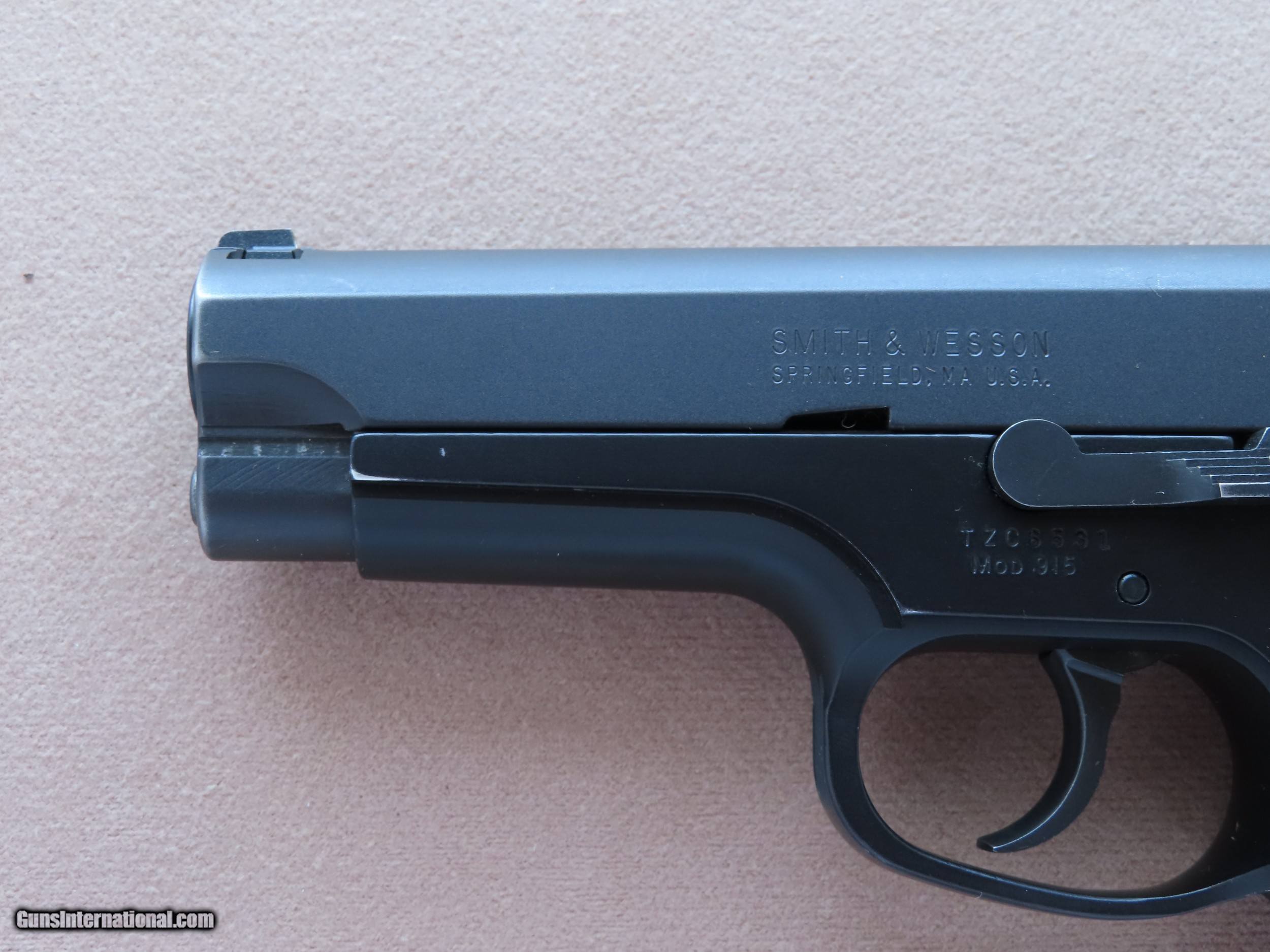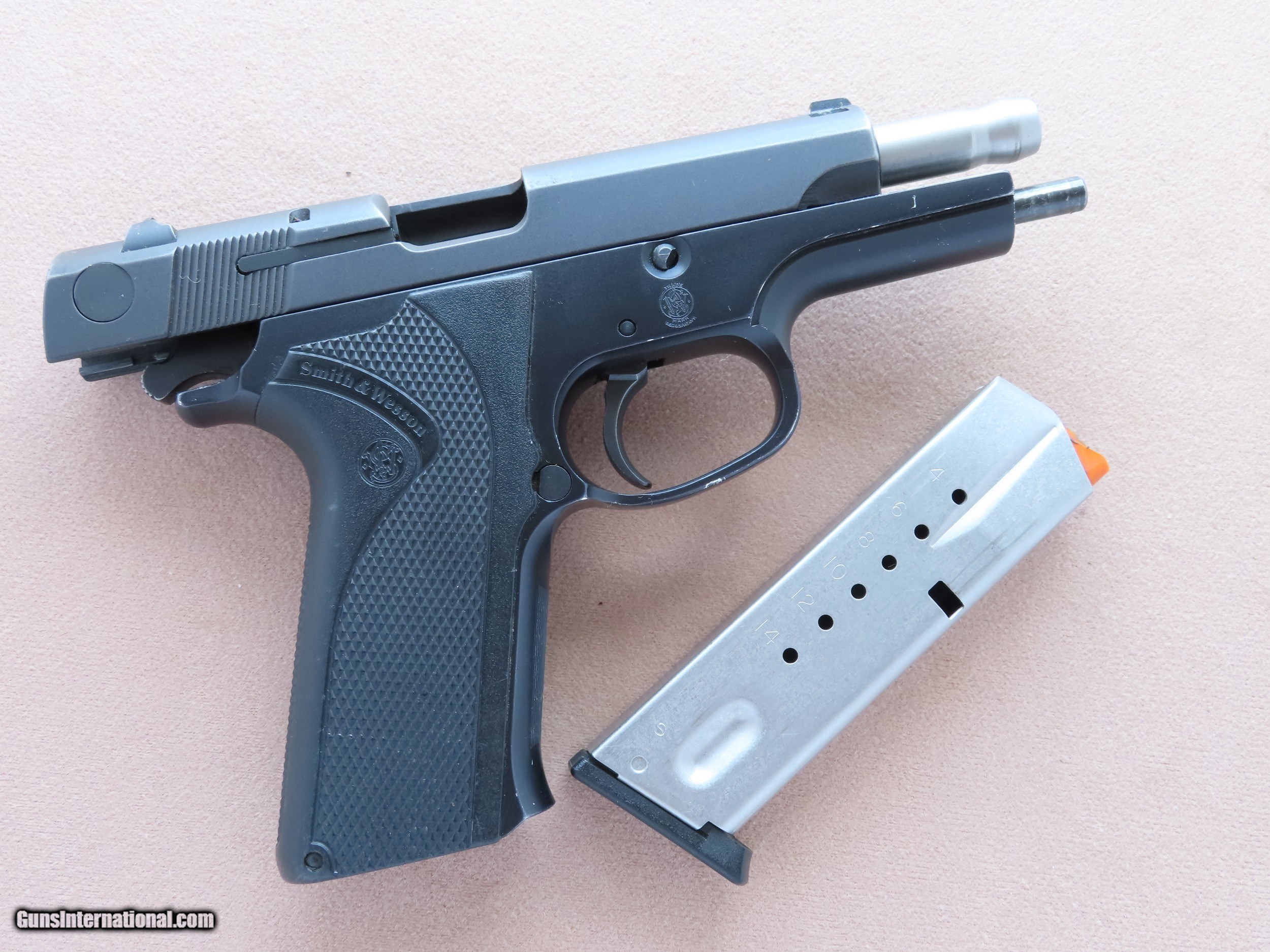- Smith And Wesson Model 915 Manual Transfer Kit
- Smith And Wesson 915 Holster
- 915 Smith And Wesson Price
Despite using a three-digit model number, both the Model 915 and the Model 910 are in fact 3rd Generation Smith & Wesson auto pistols, and were part of the Value Series that incorporated several features to cut the costs associated with manufacturing. Jun 11, 2010 This was made due to a few requests that I go over how to field strip, reassemble, and function check the S&W Model 915 pistol. I hope you all enjoy.
2018-12-11At any given moment there are firearms on the market that are conspicuously undervalued. Sometimes this is due to supply, as when an importer brings in a fresh boatload of some surplus model and they are literally everywhere at bargain prices until suddenly they are all gone and the price spikes. Other times a certain model is simply in a “down” cycle while we shooters chase some other hot trend leaving little demand for a classic this or that. These invariably turn into the shooters’ classic reminiscence: “Remember when the Colt/Smith/Ruger ABC’s were everywhere for only XYZ dollars!? I wish I had bought one then!” If you step back and look broadly at the market you can sometimes spot these buying opportunities before the market adjusts and prices a steal accordingly. This is one of those occasions.
N-Frame (The .44, or large frame) Smith & Wesson revolvers were always a premium product. The classic big-bore wheelguns hit a spell where they were bargain priced about a decade ago but have been ticking higher year more than a year for a while now. Never produced in massive numbers, collectors and the rising generation of shooters routinely outbid each other on good condition specimens of the post-war Ns. That is, with one conspicuous exception: The Highway Patrolman (later Model 28) .357 Magnum.

Introduced in 1954, the Highway Patrolman was Smith’s bid to capture more market share with law enforcement by cutting largely cosmetic costs to their existing, and premium quality, .357 Mag. (later designated the Model 27). The Highway Patrolman received a more utilitarian vice, high-gloss blue, and eschewed the extensive checkering down the top strap and barrel rib. Mechanically and internally there is no difference between the two models, although the 27 was offered in more barrel lengths than the four- and six-inch choices of the Highway Patrolman. At the time these changes led to a modest price decrease and the Highway Patrolman was quite popular. Today, however, the price difference can be dramatic. In equal condition, a Highway Patrolman can usually be found for half (often less) than a similar vintage Pre 27.
This situation has led me to the point where my armory is starting to look like a rescue shelter for homeless Model 28s. Here are five reasons to save your lunch money and get a Highway Patrolman while the “‘getting is good.”
1. The Highway Patrolman is the Muscle Car Wheelgun. One look at that large frame, sharply tapered barrel with its high rib and ramped sight and you know the era it came from. Firearms are both influenced by and ultimately become a part of the aesthetic of an era. The Highway Patrolman looks as 1950s as a ’57 Chevy Bel Air.
2.History. The Highway Patrolman was very popular with law enforcement and particularly so with the state troopers and highway patrols of sundry states. A Model 28 you pick up today stands a decent chance of having served and protected in a past life, or it may just be a perfect facsimile of the many thousands that did. I particularly enjoy shooting old service weapons as a hands-on history experience and the big Smith is a window into another time.
3. Performance. Every Model 28 I have fired has been a performer. The old pieces are exceptionally accurate with both .38 Specials and .357s. The long-barreled one in the photos fired an honest one-inch group from a barricade at 25 yards with Black Hills 158 gr. jacketed hollow points and its siblings will routinely pile wadcutters into nearly an inch. I’d offer that the Highway Patrolman was the closest thing to a laser beam ever issued out on a large scale. The magnum velocity and trajectory, target sights, and stereotypically excellent triggers allow hitting to stretch out beyond traditional limitations.
I recently walked the six inch Patrolman out to 80 yards from a Defense Targets Ready Ship Target, which is similar (if slightly smaller than) the vital zone of many law enforcement silhouettes. From a barricade, the Smith put five right where I intended, and four of those had the splatter marks nearly touching in a 3.7″ group. Eight-inch steel plates at 40 or 50 yards are easy money with the shorter barrel.
The large frame is matched well to the recoil level of the cartridge and the Model 28 soaks up full-house .357 “whap” without punishing the shooter. The classic wheelgun allows full control of current self-defense or duty-oriented .357 loads, which tend to have mid weight projectiles for caliber and are driven to less than maximum velocity. Dropping .38 Specials in the cylinder takes recoil down to an almost laughably negligible level. Running Magtech 158 gr. Specials I was able to clear the plate rack on one smoking run that was a beat or two faster than my typical compact striker fired 9 mm times.
4. Quality. Something interesting happened as our world changed. The dull finish of the Highway Patrolman is no longer quite so dull, looking comparable and perhaps superior to most of the satin blue that is offered on contemporary firearms. Of course, the dull blue bears no comparison to the outrageous polished high lustre blueing of the upscale N frames of the era, but it looks custom compared to the spray-on, bake-on standard finishes of our time.
The casehardened hammer and trigger look downright high-end in our currently polymer world. There is a smoothness and gentle precision in cocking the old Smiths that reaffirms that a craftsman fitted the connecting parts by hand and the ensuing years have worn the parts into a well honed union.
5. Value. When one looks closely at the care and hand work that went into building the classic high-polish N frames and imagine what it would cost to replicate that today, it is not hard to see their current valuation. The Highway Patrolman in most cases skirts the bidding wars, trading mostly among folks who appreciate the model for its performance and value rather than its modest collectibility. This and the greater production numbers of the 28 series create a situation where a seriously high quality and great shooting classic can be found for less than the cost of a new Glock. A new Smith & Wesson N frame .357 will run hundreds of dollars more and will have distinct differences from the vintage elder.
It is possible that a few years from now “Golden Era” N frames become passe and lose all value, but it is highly unlikely; quality and era-specific arms seem to always have a market. I would imagine that the prices will continue on a gentle rise—the 28s are undervalued as is. There may be no rush to get a Highway Patrolman, but I suspect that whenever you do, you will be glad you did.
Don't forget to like us on Facebook and follow us on Twitter.
SOLD FOR$1,275.00
LSB#: 171106MS15
Make: Smith & Wesson
Model: Model 13-3 The .357 Magnum Military & Police Heavy Barrel, Round Butt K-Frame
Serial Number: AAV9519

Year of Manufacture: 1982-1984 (13-3 introduced 1982, box has pre-1984 product code)
Caliber: .38 Special / .357 Magnum
Action Type: 6-Shot, Double / Single Action, Swing-Out Fluted Cylinder Hand Ejector Revolver.
Markings: The left side of the barrel is marked “SMITH & WESSON”, the right is marked “S.&W. 357 MAGNUM”, the right side of the frame has the four line Marcas Registradas and the left has the Smith & Wesson monogram logo. The left side of the grip frame is marked “G24″, “71543”, “D4” and “5”, the butt is marked with the serial number, the right is marked “K” in circle, “4745” and “N” in triangle. The yoke is marked “G24 / 71543”, the cut is marked “MOD. 13-3”. The rear face of the cylinder is marked “6” or “9”.

Barrel Length: 3” heavy barrel with un-shrouded ejector rod.
Sights / Optics: The front sight is a serrated ramp blade, which is integral to the barrel rib. The rear sight is a square notch, sitting before a “U” channel on the top strap of the frame.
Stock Configuration & Condition: The grips are two-piece checkered Magna walnut grips. The rear of the left panel has a scuff mark. There are a few light handling marks. There are no chips or cracks. The grips rate in about Fine-plus condition.
Type of Finish: Blued, with case colored smooth trigger and checkered hammer.
Finish Originality: Original
Bore Condition: The bore is bright, the rifling is sharp, there is no erosion.
Overall Condition: This handgun retains about 99% of its metal finish. The cylinder has a faint turn line, just starting to go through the finish in a couple of spots. There are a few very light handling marks. The screw heads are sharp. The markings are clear. Overall, this handgun rates in about Excellent condition.
Mechanics: The action functions correctly. The cylinder produces no side to side play with no back play in full lockup of all 6 chambers. The double action trigger pull is smooth, single action is crisp. We did not fire this handgun. As with all used firearms, a thorough cleaning may be necessary to meet your maintenance standards.
Smith And Wesson Model 915 Manual Transfer Kit
Box, Paperwork & Accessories: This revolver comes in a one-piece blue cardboard box with serial-matching end label, wax paper, plastic trigger post, cleaning rod and bronze-bristle brush and an assortment of factory paperwork including manual. The box has light wear at edges and corners with slight discoloration from age, in about Fine condition. The cleaning accessories are still in sealed plastic packaging. The paperwork has discolored slightly with age, in about Fine-plus condition.
Smith And Wesson 915 Holster
Our Assessment: The Smith & Wesson Model 13 is a continuation of the model 10-6 prototype with a heavy barrel and unshrouded ejector rod. This example was made between 1982 and 1984 and is still in Excellent condition with its original box, cleaning tools and paperwork. The model 13 was popular as a carry and duty gun, being issued within the FBI in 1974 and 1986-1987, the Royal Canadian Mounted Police and several other law enforcement agencies. In this condition, with its original accessories it will likely draw the eye of Smith & Wesson collectors, but this would make a fine carry, duty or home defense revolver. Please see our pictures and good luck!
915 Smith And Wesson Price
CA Legal or CA Private Party Transferable: This handgun CANNOT be transferred as a dealer sale in California. This handgun CAN be sold as a Private Party Transfer (PPT) at our Simi Valley shop.